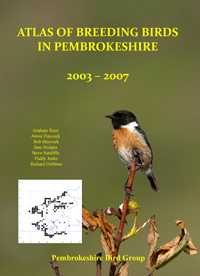The Whinchat Saxicola rubetra is a migrant breeding species favouring open country such as heathland, moorland, bogs, marshes and light scrub. The latest atlas of breeding birds in Pembrokeshire 2003-07 (Rees et al 2009) found that their distribution had been reduced by 70% in comparison to the 1984-1988 atlas. And this range contraction is accompanied by a 50% population decline. The species is currently amber listed and a local priority species.
The aims of this survey are to record in detail the current breeding status and distribution of whinchats in Pembrokeshire, and to relate this distribution to habitat. This will lead to a greater understanding of habitat requirements and enable practical land management advice to aid their conservation within the PCNP.
A set of sites where whinchats have bred in recent years within the PCNP were surveyed; St David’s Head, Dowrog, Fagwr Goch, Carn Ingli, Fronlas and Brynberian Moor. Several additional sites were visited on an ad hoc basis. These were; Pantmaenog, North Preseli east of Brynberian, Mynydd Crwn, Afon Wern.
An initial visit was made to each of these sites between 20th May and 10th June and follow up visits were made between 19th June and 5th July.
No breeding Whinchats were found at either of the St David’s sites and neither did they appear at the two farms south of the Preseli ridge; Fronlas or Fagwr Goch.
A total of 29 pairs were found spread across all the remaining sites with 15 of these at Brynberian Moor.
14 nests were located and based on 11 successful nests for which brood size was known (across all sites) productivity was 4.5 young per nest.
All breeding pairs occupied a mosaic of bracken, low bushes of various species and a wet area such as a gully or flush.
The reasons for the decline in the local Whinchat population were considered. Productivity data are represented by a small sample but based on this surveys results it appears to be near the national average for first broods. There was unoccupied but apparently suitable breeding habitat, suggesting that recruitment is low, possibly caused by factors away from their breeding sites. There was no evidence that Stonechats displaced breeding Whinchats and predation was considered to be an insignificant factor.
Practical habitat management to favour breeding Whinchats is discussed. The current grazing regime at Brynberian Moor is already well suited to maintaining good whinchat habitat, so it is not necessary to change current practise. Targeted burning of bracken near gullies and mature gorse is likely to be detrimental to the population. Creating small isolated pockets of Whinchat habitat at new sites will probably be ineffective as long as there remains unoccupied suitable habitat.
Whinchats are a very easy species to census, with a single visit made to their breeding sites any time between mid-May and the end of June producing identical and reliable results, and by ringing chicks during June and July a very valuable data set can be established over a few years.
Read the full report here
Paddy Jenks, Tansy Knight & Jane Hodges
 Sunday, April 27, 2014 at 6:52PM
Sunday, April 27, 2014 at 6:52PM  Pembrokeshire Avifauna committee | Comments Off |
Pembrokeshire Avifauna committee | Comments Off | 




